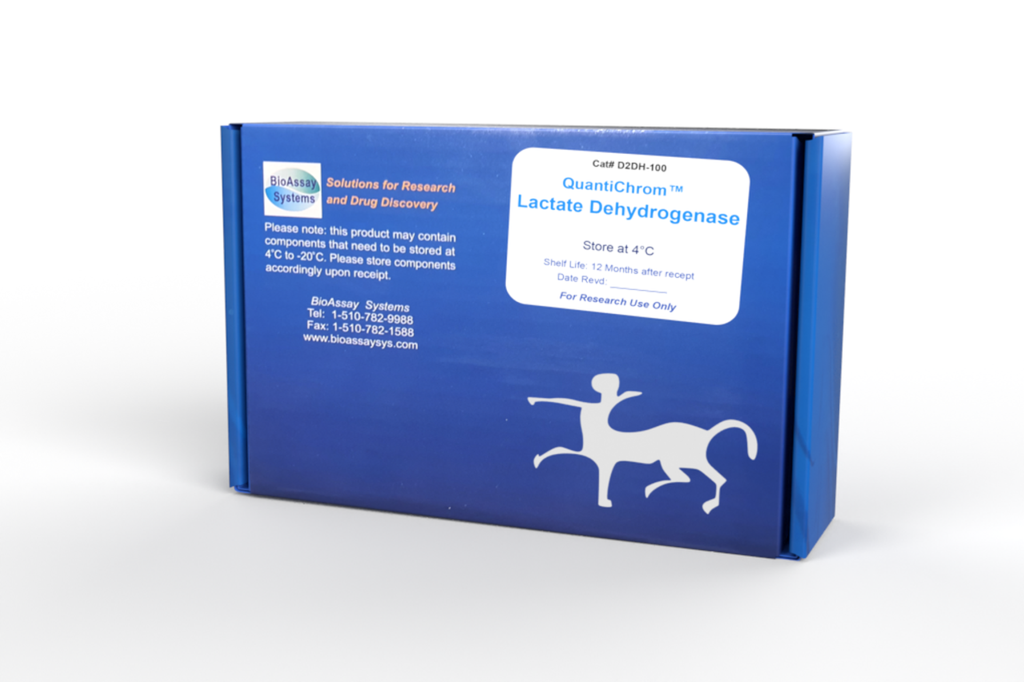DESCRIPTION
LACTATE DEHYDROGENASE (LDH) is an oxidoreductase which catalyzes the interconversion of lactate and pyruvate. When disease or injury affects tissues containing LDH, the cells release LDH into the bloodstream, where it is identified in higher than normal levels. Therefore, LDH is most often measured to evaluate the presence of tissue or cell damage. The non-radioactive colorimetric LDH assay is based on the reduction of the tetrazolium salt MTT in a NADH-coupled enzymatic reaction to a reduced form of MTT which exhibits an absorption maximum at 565 nm. The intensity of the purple color formed is directly proportional to the enzyme activity.
KEY FEATURES
High sensitivity and wide linear range. Use 3 µL serum or plasma sample. The detection limit is 2 IU/L, linear up to 200 IU/L. Homogeneous and simple procedure. Simple “mix-and-measure” procedure allows reliable quantitation of LDH activity within 30 minutes. Robust and amenable to HTS. All reagents are compatible with highthroughput liquid handling instruments. APPLICATIONS Direct Assays: LDH activity in serum, plasma and other sources. Characterization and Quality Control for LDH production. Drug Discovery: screen and evaluation of LDH modulators.
KIT CONTENTS
(100 TESTS IN 96-WELL PLATES)
Substrate Buffer: 20 mL Diaphorase: 120 µL
NAD Solution: 1 mL Calibrator: 1.5 mL
MTT Solution: 1.5 mL
Storage conditions. The kit is shipped at ambient temperature. Store all
components at -20°C upon receiving. Shelf life: 6 months after receipt.
Precautions: reagents are for research use only. Normal precautions for
laboratory reagents should be exercised while using the reagents. Please
refer to Material Safety Data Sheet for detailed information.
PROCEDURES
This assay is based on a kinetic reaction. To ensure identical incubation time, addition of Working Reagent to samples should be quick and mixing should be brief but thorough. Use of a multi-channel pipettor is recommended. Assays can be executed at room temperature (25°C) or 37°C.
Sample Preparation: Serum and plasma are assayed directly. Tissue: prior to dissection, rinse tissue in phosphate buffered saline (pH 7.4) to remove blood. Homogenize tissue in 5 mL buffer containing 100 mM potassium phosphate (pH 7.0) and 2 mM EDTA, per gram tissue. Centrifuge at 10,000 x g for 15 min at 4°C. Remove supernatant for assay. Cell Lysate: collect cells by centrifugation at 2,000 x g for 5 min at 4°C. For adherent cells, do not harvest cells using proteolytic enzymes; rather use a rubber policeman. Homogenize or sonicate cells in an appropriate volume of cold buffer containing 100 mM potassium phosphate (pH 7.0) and 2 mM EDTA. Centrifuge at 10,000 g for 15 min at 4°C. Remove supernatant for assay. All samples can be stored at –20 to –80°C for at least one month.
Reagent Preparation: Equilibrate reagents to desired reaction temperature (e.g. 25°C or 37°C). Briefly centrifuge reagent tubes before use. Prepare sufficient Working Reagent (WR) for all sample wells by mixing, for each well: 14 µL MTT Solution, 8 µL NAD Solution, 1 µL Diaphorase and 175 µL Substrate Buffer. Fresh reconstitution is recommended.
Assay Procedure:
1. Transfer 200 µL H2O (ODH2O) and 200 µL Calibrator (ODCAL) solution into separate wells of a clear flat bottom 96-well plate.
2. Transfer 10 µL of each sample into separate wells and then add 190 µL WR to each sample well. Tap plate briefly to mix.
3. Read OD565nm immediately (ODS0), and again after 25 min (ODS25) on a plate reader.
CALCULATION
LDH activity can then be calculated as follows:
where ODS25 and ODS0 are OD565nm values of sample at 25 min and 0 min. εmtt is the molar absorption coefficient of reduced MTT. l is the light pathlength which is calculated from the calibrator. ODCAL and ODH20 are OD565nm values of the Calibrator and water. Reaction Vol and Sample Vol are 200 µL and 10 µL, respectively. n is the dilution factor. Note: if sample LDH activity exceeds 200 IU/L, dilute samples in water and repeat the assay. Unit definition: 1 Unit (IU) of LDH will catalyze the conversion of 1 µmole of lactate to pyruvate per min at pH 8.2.
MATERIALS REQUIRED, BUT NOT PROVIDED
Pipetting devices and accessories (e.g. multi-channel pipettor), clear flat bottom 96-well plates (e.g. e.g. VWR cat# 82050-760) or cuvettes and plate reader or spectrophotometer capable of measuring OD 565 nm.
EXAMPLES
Samples were assayed using the 96-well plate protocol. The LDH activity (IU/L) was 41 for a human serum, 220 for rat serum and 88 for fetal bovine serum, respectively.
PUBLICATIONS
1. Gabel, M et al (2020). Annexin A2 Egress during Calcium-Regulated Exocytosis in Neuroendocrine Cells. Cells, 9(9), E2059.
2. Sharabi, K. et al (2017). Selective chemical inhibition of PGC-1alpha
gluconeogenic activity ameliorates type 2 diabetes. Cell, 169(1), 148-
160.
3. Demers, M., et al. (2011). Increased efficacy of breast cancer
chemotherapy in thrombocytopenic mice. Cancer Res 71(5):1540-9.
